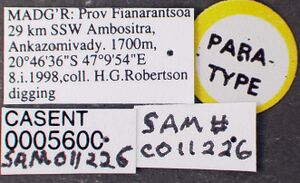Strumigenys manga
| Strumigenys manga | |
|---|---|

| |
| Scientific classification | |
| Kingdom: | Animalia |
| Phylum: | Arthropoda |
| Class: | Insecta |
| Order: | Hymenoptera |
| Family: | Formicidae |
| Subfamily: | Myrmicinae |
| Tribe: | Attini |
| Genus: | Strumigenys |
| Species: | S. manga |
| Binomial name | |
| Strumigenys manga Fisher, 2000 | |
A soil nest of this species was found in a disturbed forest.
Identification
Bolton (2000) - A member of the abdera complex in the Strumigenys arnoldi-group. S. manga is separated from the other species in the arnoldi-group with 6 antennal segments by the presence of an erect pronotal humeral hair, presence of hairs on anterolateral margin of mesonotum, and the shape of the alitrunk in profile which is convex anteriorly and more or less flat posteriorly.
Keys including this Species
Distribution
Latitudinal Distribution Pattern
Latitudinal Range: -20.76833333° to -20.777°.
| North Temperate |
North Subtropical |
Tropical | South Subtropical |
South Temperate |
- Source: AntMaps
Distribution based on Regional Taxon Lists
Malagasy Region: Madagascar (type locality).
Distribution based on AntMaps
Distribution based on AntWeb specimens
Check data from AntWeb
Countries Occupied
| Number of countries occupied by this species based on AntWiki Regional Taxon Lists. In general, fewer countries occupied indicates a narrower range, while more countries indicates a more widespread species. |

|
Estimated Abundance
| Relative abundance based on number of AntMaps records per species (this species within the purple bar). Fewer records (to the left) indicates a less abundant/encountered species while more records (to the right) indicates more abundant/encountered species. |

|
Biology
|
Castes
Worker
Images from AntWeb
   
| |
| Worker. Specimen code casent0005601. Photographer April Nobile, uploaded by California Academy of Sciences. | Owned by CAS, San Francisco, CA, USA. |
Queen
Images from AntWeb
   
| |
| Paratype of Strumigenys manga. Queen (alate/dealate). Specimen code casent0005600. Photographer April Nobile, uploaded by California Academy of Sciences. | Owned by CAS, San Francisco, CA, USA. |
Nomenclature
The following information is derived from Barry Bolton's Online Catalogue of the Ants of the World.
- manga. Strumigenys manga Fisher, in Bolton, 2000: 634 (w.q.) MADAGASCAR.
Unless otherwise noted the text for the remainder of this section is reported from the publication that includes the original description.
Description
Worker
Holotype. TL 2.4, HL 0.56, HW 0.49, CI 88, ML 0.22, MI 40, SL 0.26, SI 53, PW 0.29, AL 0.63. Characters of abdera-complex. Left mandible with a distal preapical denticle and a proximal preapical tooth; right mandible with a small distal preapical tooth and a proximal preapical tooth. Cephalic dorsum posterior of clypeal margin and upper scrobe margin with clavate to spoon-shaped hairs that are distinctly narrower than the hairs on leading edge of scape. Cephalic dorsum with a transverse row of 4 erect, short clavate hairs close to the occipital margin. Pronotal humeral hair present, stiffly projecting; mesonotum with a short clavate hair on lateral anterior margin. In profile, outline of alitrunk convex in anterior half, more or less flat in posterior half; anterior mesonotal dorsum steeply descending to its posterior half. Propodeal dorsum more or less flat and meeting the declivity in rounded angle without a noticeable cuticular tooth. In profile, spongiform lamella continuous down propodeal declivity and marginate medially, forming a triangular tooth at apex of declivity. Ventral spongiform tissue and lateral lobes well developed and conspicuous on petiole and postpetiole; petiolar lamella notched medially. Base of first gastral tergite with basal costulae arising on each side of a central clear area. Dorsal surfaces of petiole, postpetiole, and gaster with clavate standing hairs. Color brown.
Paratypes. TL 2.5, HL 0.56-0.57, HW 0.51-0.52, CI 90-91, ML 0.22, MI 39, SL 0.30 SI 59-60, PW 0.30-0.31, AL 0.65-0.67 (2 measured). As holotype.
Type Material
Holotype worker, Madagascar: Foret d' Ankazomivady, 29 km. SSW Ambositra, 1700 m., 20°46'36"S, 47°9'54"E, 8.i.1998, disturbed forest, nest 3 cm. below leaf-litter covered soil surface found by digging SAM#011226 (H.R. Robertson) (South African Museum).
Paratypes. 2 worker and 1 queen (dealate) with same data as holotype (The Natural History Museum).
References
- Fisher, B.L. 2000. The Malagasy fauna of Strumigenys. Pp. 612-696 in: Bolton, B. 2000. The ant tribe Dacetini. Memoirs of the American Entomological Institute. 65:1-1028. (page 634, worker described)
References based on Global Ant Biodiversity Informatics
- Bolton, B. 2000. The Ant Tribe Dacetini. Memoirs of the American Entomological Institute 65
- Fisher B. L. 2003. Formicidae, ants. Pp. 811-819 in: Goodman, S. M.; Benstead, J. P. (eds.) 2003. The natural history of Madagascar. Chicago: University of Chicago Press, xxi + 1709 pp.
- Fisher, B.L. and H.G. Robertson. 2002. Comparison and Origin of Forest and Grassland Ant Assemblages in the High Plateau of Madagascar (Hymenoptera: Formicidae). Biotropica 34(1):155-167.

